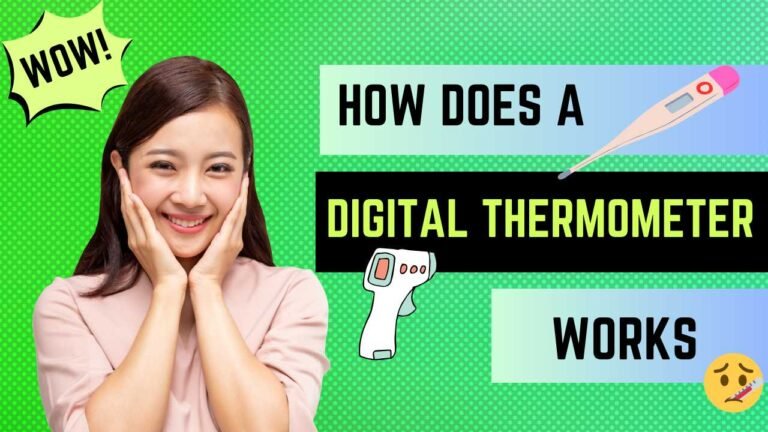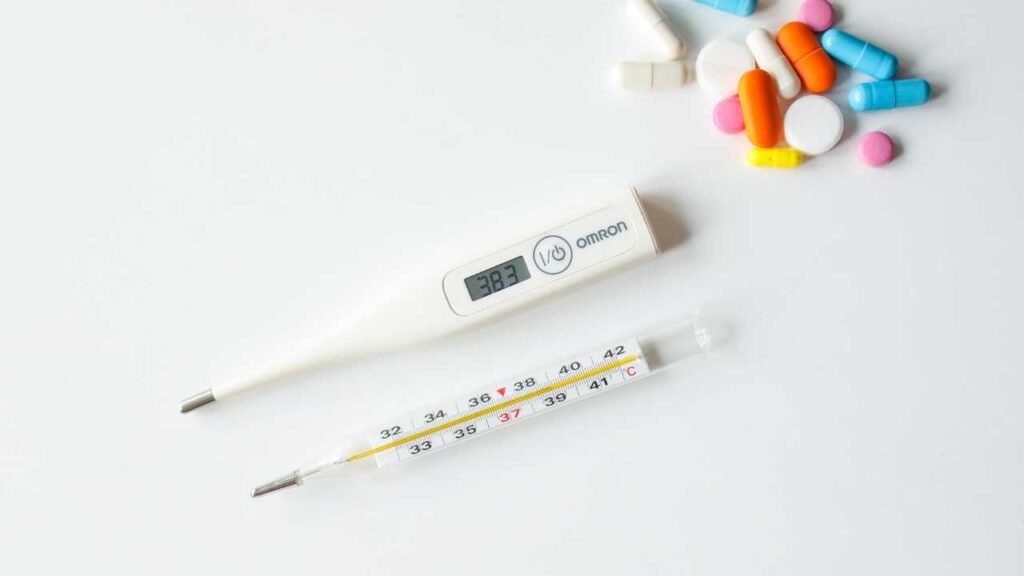Introduction to Digital Thermometers
In today’s fast-paced world, it’s important to be able to measure temperature accurately, whether at home, in a hospital, in a lab, or even in an industrial setting.
One of the most reliable tools for getting quick and accurate readings is a digital thermometers. These electronic devices have taken the place of old-fashioned mercury thermometers because they respond faster, are safer, and have displays that are easy to read.
Choosing the right thermometer can help you get accurate results every time, whether you’re checking for fever, room temperature, or scientific samples.
We’ll go into more detail about these useful tools in this post, explaining how a digital thermometer works and pointing out the benefits of using one over a regular mercury thermometer.
What Is a Digital Thermometer?
A digital thermometer is an electronic device that measures temperature using a sensitive sensor instead of mercury. It displays the value digitally, making readings easy and error-free. You can find them in hospitals, homes, laboratories, and industries.
Because they are quick, safe, and versatile, digital thermometers are considered the best thermometers for everyday use.
Parts of a Digital Thermometer
A typical digital thermometer includes:
- Temperature Sensor: Converts heat into electrical signals
- Microprocessor: Processes data and calculates temperature
- Display Screen: Shows readings
- Start Button: Activates the device
- Battery Compartment: Powers the system
- Protective Casing: Ensures durability
- Flexible or Rigid Tip: For oral, rectal, or underarm measurement
Understanding the parts of a thermometer helps you better maintain and use the device correctly.
How Does a Digital Thermometer Work?
Digital thermometers work like tiny computers. Instead of mercury expansion, they use thermistors or infrared sensors to detect temperature.
Here’s a simple explanation of how a digital thermometer works:
1. Sensor Activation
When you place the thermometer on a warm surface or body part, the sensor detects heat.
2. Signal Conversion
The thermometer converts this heat into an electrical signal.
3. Processing
The built-in microcontroller interprets the signal and calculates the temperature.
4. Display
The result appears on the LCD screen—clear and easy to read.
This entire process takes only a few seconds, making digital thermometers faster than traditional mercury devices.
Types of Digital Thermometers
Understanding the types of thermometers available helps you pick the right one.
1. Digital Oral Thermometer
- Best for home use; placed under the tongue.
- Ideal for accurate and quick readings.
2. Ear Thermometer (Tympanic Thermometer)
- Uses infrared light to detect heat from the eardrum.
- Perfect for kids and adults who prefer a painless, fast method.
- Often considered the best thermometer for toddlers.
3. Forehead (Temporal) Thermometer
- Non-contact infrared thermometer that reads heat from the forehead.
- Useful for schools, airports, clinics, and mass screening.
4. Clinical Thermometer
- Includes digital oral, rectal, ear, and underarm thermometers.
- Designed specifically for measuring human body temperature.
5. Laboratory Thermometer
- Used in laboratories for experiments and chemical reactions.
- Has higher temperature ranges and better precision.
6. Electronic Thermometer
Another name for digital thermometers but may include advanced sensors and multiple modes.
7. Temperature Meter / Temperature Checker
Used in industrial, HVAC, and environmental testing.
Also known as digital temperature meters.
8. IR (Infrared) Thermometer
- Measures temperature without touching the object.
- Popular during health screenings and industrial inspections.
- People often search for IR thermometer price, making them a trending choice in contactless measurement.
Digital thermometers come in a variety of types, each suited for a specific use. Also, each digital thermometer has its pros and cons, depending on who’s using it and how comfortable they are with the method.
Clinical, Laboratory & Electronic Thermometers: Key Differences
Clinical Thermometer
- Designed for human body temperature
- Comes in oral, rectal, ear, and armpit variations
Laboratory Thermometer
- Used in scientific labs
- Measures high and low temperatures of chemicals, solutions, and equipment
- Not suitable for the human body
Electronic Thermometer
- Can refer to any battery-powered thermometer
- Includes contact and non-contact devices
 Digital vs Mercury Thermometers
Digital vs Mercury Thermometers
Digital thermometers have replaced mercury models due to several advantages:
| Feature | Digital Thermometer | Mercury Thermometer |
|---|---|---|
| Safety | No mercury, non-toxic | Contains toxic mercury |
| Speed | 1–10 seconds | Slow reading |
| Display | Digital, easy to read | Requires interpretation |
| Features | Memory, fever alert, backlight | No advanced features |
| Accuracy | Highly accurate | Accurate but slow |
Accuracy of Digital Thermometers
Most digital thermometers are accurate within:
- ±0.1°C or
- ±0.2°F
Accuracy improves when the thermometer is used as per instructions and regularly cleaned and calibrated.
Uses of Thermometer
A thermometer is used in:
- Measuring human body temperature
- Laboratory research
- Food processing
- Environmental monitoring
- Industrial machinery inspection
- Refrigeration and HVAC testing
- Medical diagnosis
Understanding the uses of thermometer helps you choose the right type for your purpose.
Maintaining Your Digital Thermometer
To ensure longevity and accuracy, regular maintenance of your digital thermometer is crucial:
- Clean regularly with alcohol wipes
- Replace batteries when needed
- Store in a dry area
- Calibrate periodically (especially laboratory and temperature meters)
- Avoid dropping to protect sensors
Also read – How Propane Refrigerator Works?
List of top 10 digital thermometers
- Beurer FT 65 Multi-Functional Thermometer: This versatile thermometer offers six functions in one device. It can measure ear, forehead, and surface temperatures, as well as room temperature, and features a clock. It’s known for its quick readings and fever alarm function.
- Health Sense Thermometer: Known for its reliability and accuracy, the Health Sense thermometer features a clear digital display and user-friendly design, making it suitable for all ages.
- Ink bird ITH-10 Digital Thermometer: This compact and easy-to-use digital thermometer provides quick and accurate temperature readings, with a simple design ideal for everyday use.
- Dr Trust Forehead Digital Infrared Thermometer: This non-contact infrared thermometer from Dr Trust allows for hygienic and convenient temperature measurement. It’s designed for forehead use and offers quick results, making it great for use with children.
- DR VAKU® Infrared Digital Thermometer: The DR VAKU® thermometer is an infrared, non-contact device designed for fast and accurate readings. It’s often used for measuring body, surface, and ambient temperatures without direct contact.
- Dr Trust Waterproof Flexible Tip Digital Thermometer: Featuring a flexible tip for comfort and safety, this digital thermometer from Dr Trust is waterproof, making it easy to clean and ideal for oral, rectal, or underarm use.
- Omron Glass Mc 246 Digital Thermometer: The Omron MC 246 is a standard digital thermometer known for its accuracy and ease of use. It is suitable for taking oral, rectal, or underarm temperatures.
- Beurer FT-09 Digital Oral Thermometer: The Beurer FT-09 is a straightforward digital thermometer designed primarily for oral use. It offers accurate readings and has a basic, user-friendly interface.
- Rossmax TG380 Flexible Tip Thermometer: This thermometer features a flexible tip for added comfort and safety. It’s a digital device that provides quick and accurate readings, suitable for all age groups.
- AccuSure Highly Accurate Digital Thermometer: The AccuSure digital thermometer is praised for its high accuracy and reliability. It features a clear display and is designed for easy use, providing quick temperature readings.
Conclusion
A digital thermometer is one of the most essential tools in modern health monitoring. With quick response time, high accuracy, and easy operation, digital, infrared, and electronic thermometers have become indispensable in homes, clinics, and laboratories.
Understanding the types of thermometer, parts of thermometer, and uses of thermometer helps you choose the best thermometer for your needs.
Choose one that fits your family’s needs and rest a little easier knowing you’re prepared. Stay healthy and informed!
Also read – How Does a Microwave Work to Heat Food?
Frequently Asked Questions (FAQs)
This FAQ section is designed to provide quick and clear answers to the most common inquiries we receive. We encourage you to click on a question to find the information you need. If you can’t find an answer here, please don’t hesitate to visit our Contact Us page for further assistance.
Who invented the thermometer?
The modern thermometer was invented by Galileo Galilei in the early 1600s, while the mercury-in-glass thermometer was later developed by Daniel Gabriel Fahrenheit. These discoveries laid the foundation for all types of thermometers used today—from clinical thermometers to digital temperature meters and temperature guns.
What is the tharmameter prize or tharma meter price?
Many users search for “tharmameter prize” or “tharma meter price,” referring to the cost of a thermometer. Prices vary depending on the type:
- Digital thermometer: ₹150–₹500
- IR thermometer (temperature gun): ₹800–₹3000
- Omron thermometer: ₹250–₹1200
- Electronic thermometer: ₹200–₹600
The price depends on features, accuracy, and brand reliability.
What are the uses of a thermometer?
A thermometer is used to measure body temperature, water temperature, lab solutions, food temperatures, weather conditions, and more. The uses of thermometer vary across home healthcare, laboratories, classrooms, kitchens, and industries.
What is a temperature gun?
A temperature gun (also called an IR thermometer) is a non-contact device that measures surface and body temperature using infrared technology. It is widely used in hospitals, offices, airports, and fever screening setups.
What is an electronic thermometer?
An electronic thermometer is a digital device that uses sensors to measure temperature and displays the reading on an LCD screen. Examples include digital thermometers, fever thermometers, fever check machines, and temperature check machines.
Who discovered the thermometer?
The concept of measuring temperature was first discovered by Santorio Santorio, who created the earliest clinical temperature measurement device. Later, scientists like Fahrenheit and Celsius refined it, giving rise to modern temperature metres and temperature machines.
What are the different types of thermometers?
There are many types of thermometer, including:
- Digital thermometer
- IR thermometer (infrared)
- Clinical thermometer
- Laboratory thermometer
- Temperature gun
- Electronic thermometer
- Fever check thermometer
Students often study 4 types of thermometer in Class 7, and many guides include types of thermometer with names and pictures for easy learning.
What is a laboratory thermometer?
A laboratory thermometer is a precision instrument used in scientific labs to measure temperatures of chemicals, solutions, and experiments. Unlike clinical thermometers, it is not used on the human body. It typically has a higher temperature range and greater accuracy.
How to use a thermometer correctly?
To use a thermometer:
- Clean the probe.
- Place it in the mouth, underarm, or ear depending on the type (oral thermometer, ear thermometer, etc.).
- Turn on the device.
- Wait for the beep or reading.
- Read the displayed temperature.
This applies to digital temperature meters, fever thermometers, and even temperature thermometers used at home.
Which instrument is used to measure temperature?
A thermometer is the instrument used to measure temperature. Depending on the need, people use:
- Digital thermometer
- IR thermometer
- Temperature meter
- Temperature gun
- Omron thermometer
Choosing the best thermometer depends on accuracy, speed, and comfort.
Having any queries? – Do reach us at info@scivoyage.com




 Digital vs Mercury Thermometers
Digital vs Mercury Thermometers








2 thoughts on “How does a digital thermometer works?”
I have recently started a blog, the information you provide on this site has helped me greatly. Thanks for all of your time & work.
You are my aspiration, I have few blogs and rarely run out from brand :). “Fiat justitia et pereat mundus.Let justice be done, though the world perish.” by Ferdinand I.